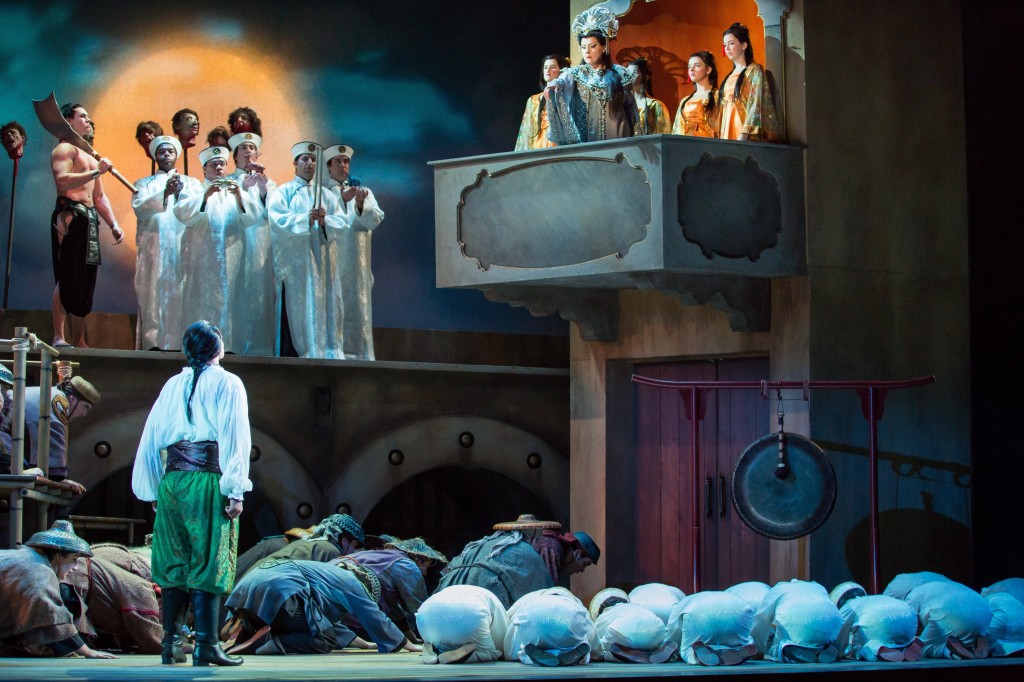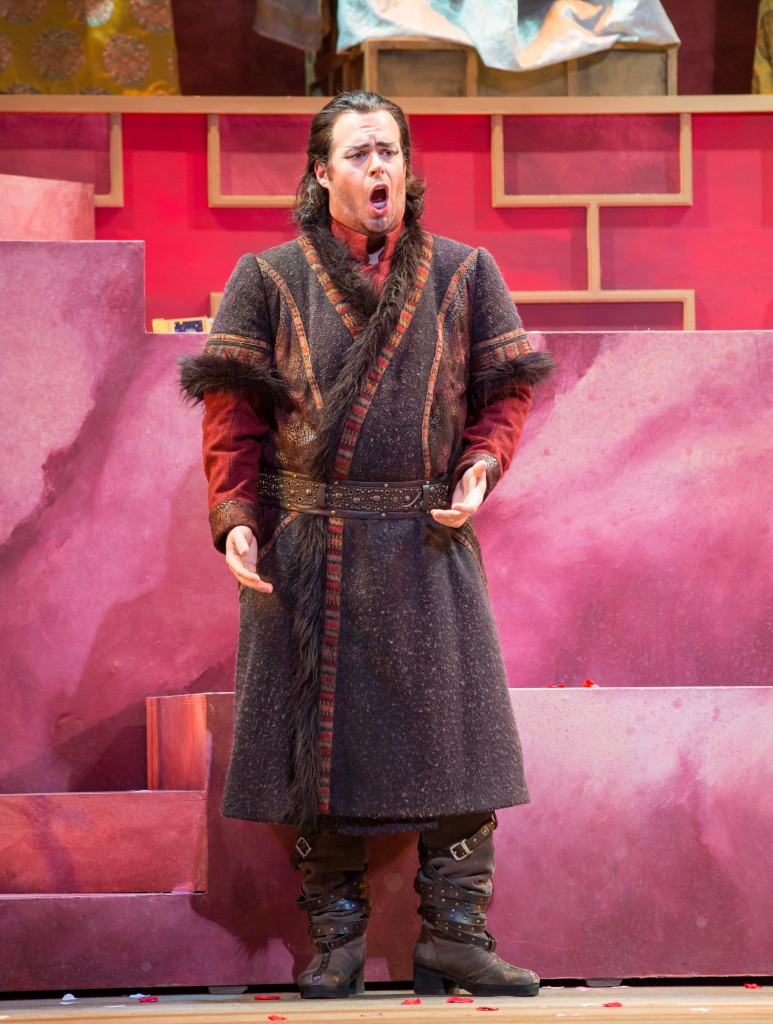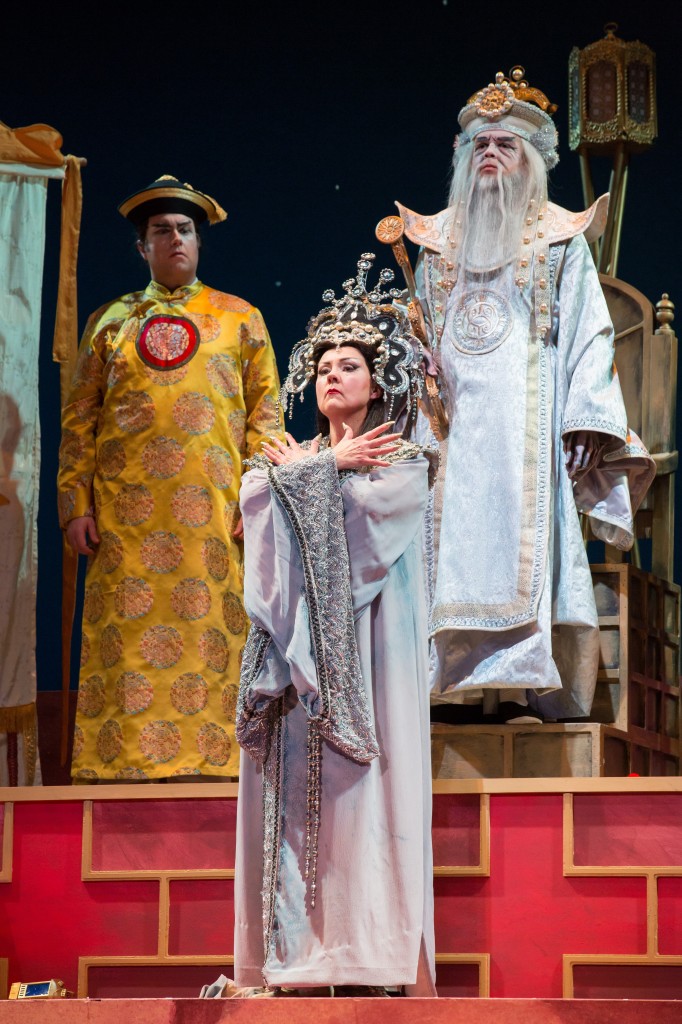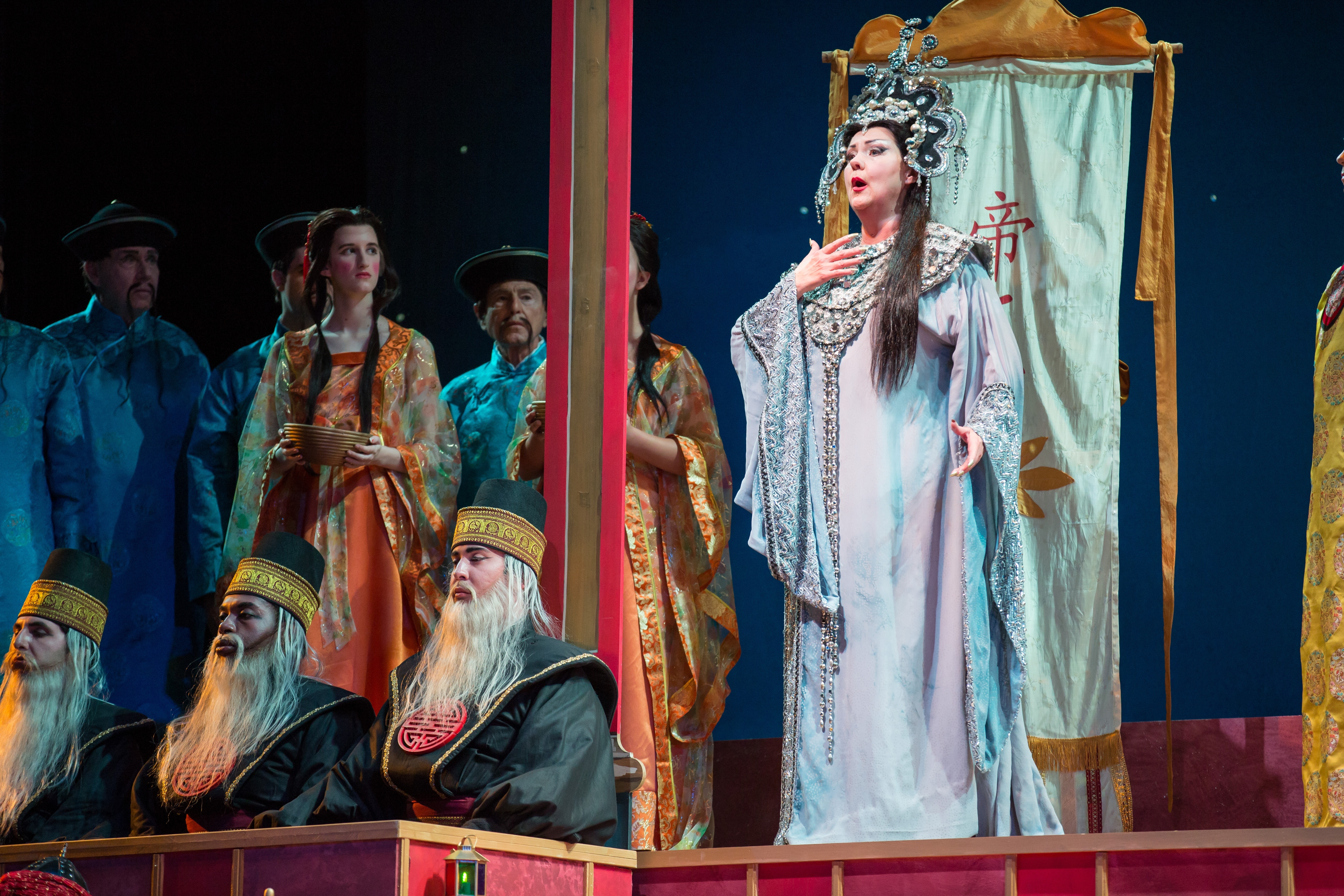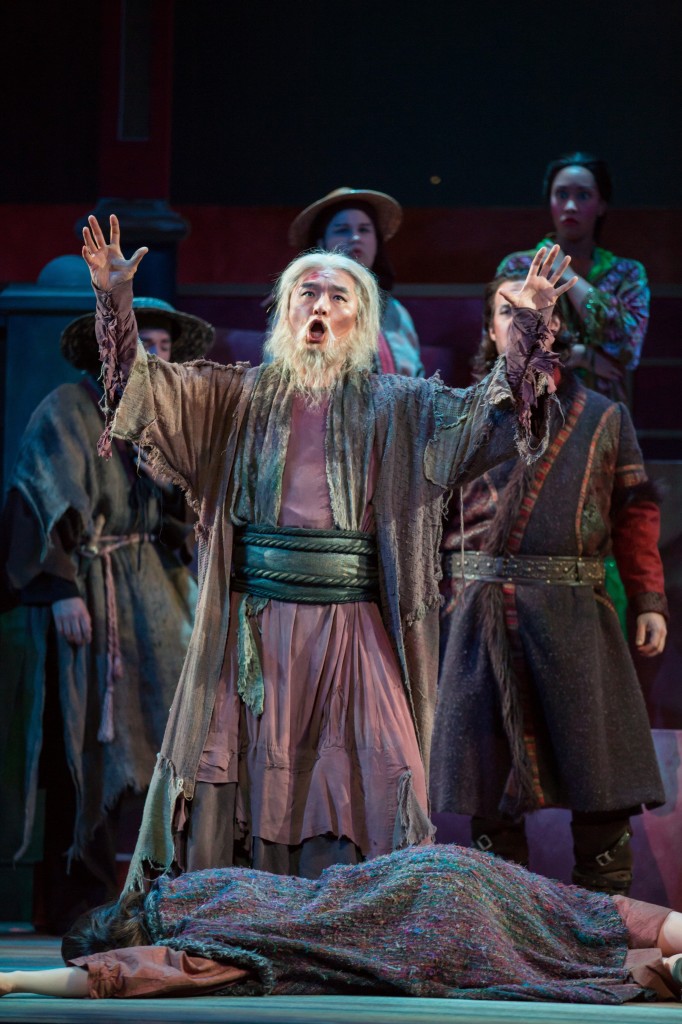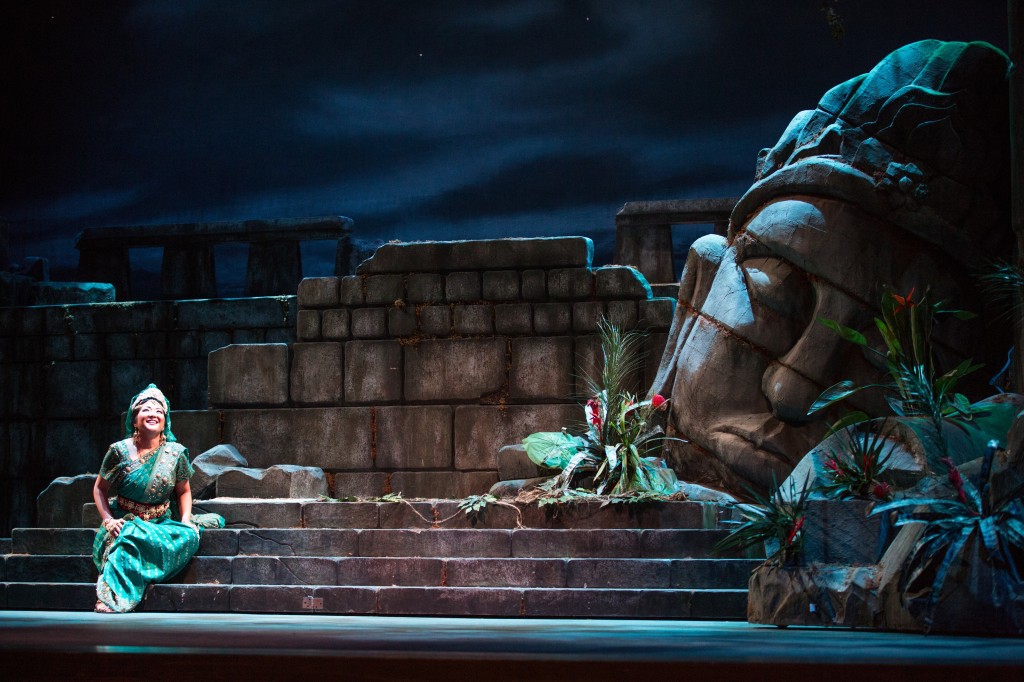February 2013. An icy nor’easter has taken over the North Eastern United States, causing millions to remain indoors in fearful hibernation. But it matters little, as newoutpost reports this bulletin from Sarasota Florida, where a balmy 85 degrees seems the norm. The purpose of our visit, of course, concerns the opening of Sarasota Opera’s Winter Festival season, beginning with the company’s debut of Puccini’s timeless Turandot in conjunction with Bizet’s rare work, Les pecheurs de perles. For the sake of keeping our business organized, we will first focus on Sarasota’s efforts towards the Puccini work, which we witnessed on two occasions.
In terms of staging, Puccini’s Turandot must have presented a daunting challenge for stage director Stephanie Sundine and her scenic designer Michael Schweikardt. While some may have reverted to conceptualize the opera to a simpler, modern solution, Sundine and Schweikardt faced the challenge of reducing a more traditional aesthetic within the limiting proportions of the William E. schmidt Opera theatre head on, and though the sets were sparse, they facilitated the needs of the principals well enough. The direction faltered to an extent in its treatment of the Chinese magistrates Ping Pang and Pong, their commedia dell’ arte inspired choreography proved too broad for the narrowness of the venue. The presentation of the chorus as a homogeneous entity could also have benefited from a more individualistic approach, which would have appropriately mirrored the competitive nature of its rather loud players, made up entirely of members of the company’s apprentice and young artist program. At the end of the day, Ms. Sundine should be commended for successfully delivering a more than functional Turandot within the pervasive restrictions, one which consistently drew the audience’s attention to what truly mattered: The business onstage as it pertained to the principal players. And what a cast of principals it is! Sarasota Opera can proudly claim to have compiled a cast audiences would have been thrilled to hear in the 1970s. For compiling this great lineup, praise should go to the company’s Artistic Director, Victor DeRenzi, who also kept the orchestra intact from the podium in these performances of Turandot.
First in this line up is the young soprano Maria Natale, in what would appear to be her first professional engagement in a principal role in the legendary role of Liu. She is a real find: A ripe, lyric soprano voice of considerable volume and an unequivocal Italian sound, its tone is capped by that difficult to describe dome which, when unleashed through the scores of the composers of the Italian giovane scuola, is capable to create a special magic. In both presentations we attended, the voice never failed to charm by the beauty of its sound alone, first heard at its best during her uninterrupted confession to Calaf “Perché un dì nella reggia m’hai sorriso.” Here, the steady stream of warm and breezy sound, reminiscent of a junior Freni, culminated in a delightfully suspended piano at the high B flat.
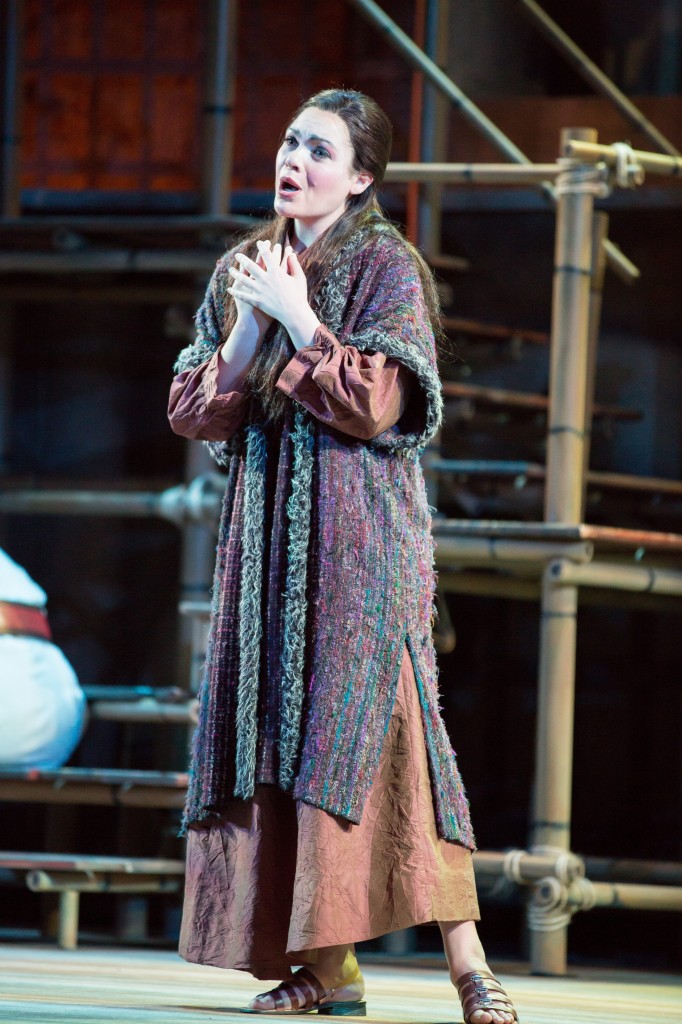
Soprano Maria Natale as Liu in Sarasota Operas production of TURANDOT. Photo by Rod Millington and Sarasota Opera
She again impressed towards the end of the first act in her lament to Calaf, the famous “Signore ascolta,” gracing the music with a young, un-tampered sound. The sustained phrases did reveal some technical limitations. As the singer skated to and from the upper passagio, the connections were so carefully pasted together as to betray the artist’s process. Also, her otherwise natural intonation was occasionally compromised when sustaining Liu’s long legato lines, at times undermining her pitch. These contrasting qualities accompanied her throughout the opera’s third act, which showcases a set of double arias for the young servant girl. Both of these numbers were affected by faulty intonation, but ultimately the delight of being bathed by the exceptional quality of this sound won out, earning this young artist a rounding ovation at the end of the evening. The introduction of Ms. Natale to the operatic firmament alone makes Sarasota’s Turandot a must see event. As of now, her proclivities make her poised to make a rapid ascent towards the big time. In the meantime, she would do well to resolve her shortcomings in order to fulfill the unlimited promise of her instrument.
The merits of this production did not stop here. The Sarasota Opera secured the services of tenor Jonathan Burton, here making his company debut and taking his first stab at the part, for the key role of the unknown Prince Calaf. This young artist, the possessor of a bronze-hued hefty tenor, made an explosive event out of his assignment by dominating the score’s challenges with seemingly wild abandon.
Calaf demands the spinto tenor to repeatedly climb the staff up to sudden high Bs and Cs, a challenge Mr. Burton accomplished with seemingly great relish. During the first half of the opera’s introductory act, he executed several of these leaps within extended dialogue passages, and towards the end of it, Mr. Burton applied this brand of exuberant vocalism into the testing aria “Non piangere Liu”. Like Ms. Natale, he impressed primarily through the brawn of his instrument, but bettered the young soprano’s efforts by way of a sound technical foundation, consistently remaining within his basic sleeve of luxurious bronze sound as he negotiated every note in the scale, including a ringing top C in the final phrase “Che non sorride piu.” As the act came to a close, Mr. Burton tipped his hat to the great Franco Corelli, performing a feat similar to those that made the career of the legendary Italian tenor. As Calaf resolved to accept the princess’ challenge, Mr. Burton let out a thunderous “Turandot!” via an interminable high A which he relentlessly suspended over the auditorium as he walked to the gong and stroked the disc three times. The audience could not handle it, and expressed their approval via enthusiastic applause. Tipped by this exuberant display, newoutpost made sure to keep an eye on our watch during the second performance in order to report the numeric equivalent of the singer’s breath control: An incredible nineteen seconds as heard on February 23.
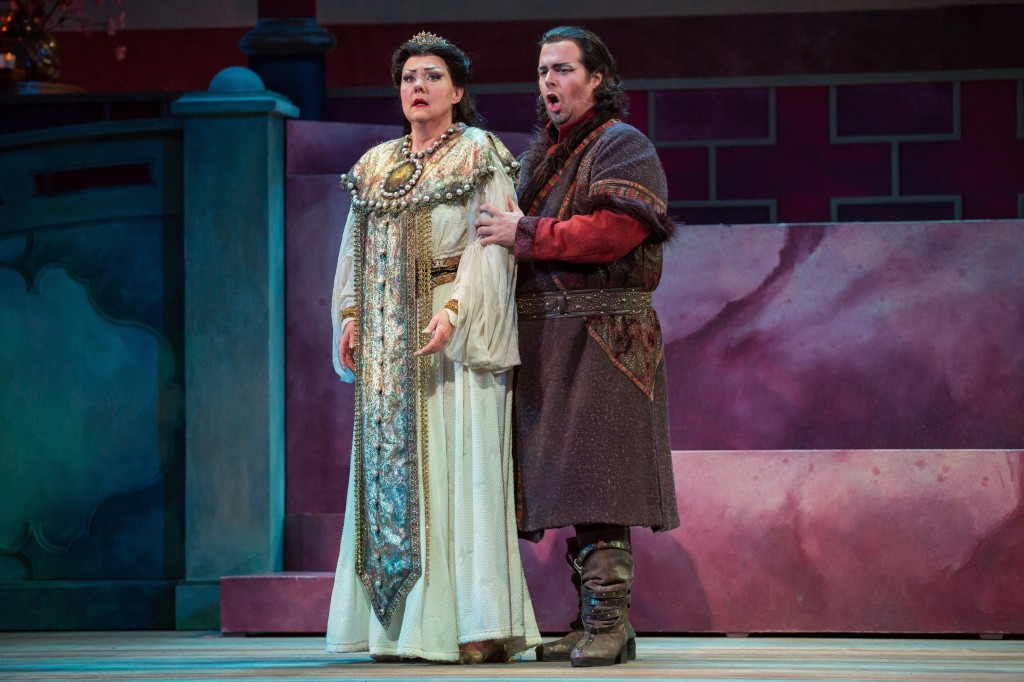
Soprano Brenda Harris as Turandot and tenor Jonathan Burton as Calaf. Photo by Rod Millington and Sarasota Opera
When the second act introduced the overwhelming Turandot of soprano Brenda Harris, Mr. Burton was her vocal match note for note, if perhaps not fully in terms of sonority, consistently demanded attention not by extending past his technique but rather by remaining within his process. The third act held the reason most Sarasota Opera patrons paid the admission fee. The famous aria “Nessun dorma” has been sung by every tenor from Giacomo Lauri-Volpi (Puccini’s intended Calaf) to Franco Corelli and Luciano Pavarotti, who made the tune into a cross over sensation (Aretha, Sarah Brightman and Paul Potts need not apply). Again, Mr. Burton did not disappoint, and as all had hoped, held unto his top notes slightly past the point of decency. We have heard plenty of fine tenors essay this role, and after banking everything into the money aria, they have been known to vocally collapse afterwards, so it was refreshing and reassuring that this was not to be Mr. Burton’s story, and he held strong until he had launched the last note of this part.
Also making her Sarasota Opera debut was soprano Brenda Harris in the first Turandots of her career. Newoutpost is no stranger to the work of the soprano dramatico d’agilita, which we have already surveyed through her extraordinary impersonations as Verdi’s Abigaille and Odabella, Donizetti’s Elizabetta in Roberto Devereux, Bellini’s Norma, among many other important assoluta parts. Yet, Puccini’s Turandot poses a different brand of vocal challenge, one which bypasses Ms. Harris’ mastery of the bel canto style and places prime demands on her ability to conquer the role’s demanding tessitura at the highest possible volume. Would she be apt to the task? It is, after all, a role that has claimed the careers of quite a few fine voices. These concerns quickly dissipated as Ms. Harris sailed into the opening bars of her introductory aria “In questa reggia.” Her first utterance displayed in full the qualities that would hallmark her entire impersonation: A well-focused, cold sound of extraordinary dimension and inexhaustible intensity.
Dramatically, she was superb, and was not afraid to sacrifice some steadiness in production in order to fulfill a musical effect demanded by the score. A very cool and overpowering tone was employed when Turandot, the public persona, addressed her subjects. The pained account of the ancient Lou-Ling demanded the complete attention and fear from all, making complete sense of the chorus’ cowered whispers “Fu quando il Re dei Tartari le sette sue bandiere dispiegò”. Intent was portrayed primarily through her instrument, the vocal face changing as she addressed those hapless youths who had gambled and lost before her, coupled with an inescapable tonal frown towards her new suitor (“And now you, fool!”), which culminated in the icy, secure, and self gratifying high C’s which crowned the aria and simultaneously made her warnings to the prince the more terrifying as she buried him with her voice. While these fine moments remained in the ear long after the curtain came down, Ms. Harris’ most memorable feat took place after this exchange, once all had calmed in preparation for the riddle trials. “Straniero ascolta!” she shrieked, and the way she dropped the first word and attacked the second somehow instantly communicated her menacing intent, sending shivers down the spine of many, including myself. This gesture gave way to the infamous riddle scene, the first of which Ms. Harris delivered with a casual authority, surely no prince has ever passed this initial question. As she delivered the second challenge, the voice betrayed a hint of anxiety at the mere possibility of failure. The third riddle was a poker game. Ms. Harris again returning to the cooler side of her palette, ironically presented herself to the confused Calaf as she reassured him of the direness of his position, making Calaf’s victory the more devastating.
The now defeated Turandot begged her father to make it all go away in the classic “Figlio del cielo,” a testing bit where the soprano must triumph over orchestra and chorus with a sustained full high C, a feat which Ms. Harris accomplished with no apparent difficulty. The operas final act showed her at her most human, the transformation from stern child to vulnerable, fearful young woman fully realized through the art of phrasing and inflection. She retained the cooler shades at the launch of the opera’s final duet, but these were replaced by a more womanly and vibrant declamation following Calaf’s kiss. It was thus a shame that when the princess gets to mourn the Turandot who is no more (Ah! Del primo pianto,) the orchestral pace dictated by maestro DeRenzi rushed the lamentation into a bit of a tongue twister. This is a key moment not only exposing the princess’ very private tragedy, but also helps further reassure Calaf’s infatuation with her. It sadly flew by a tad quickly, but did little to undermine an interpretation that, despite being a new addition in the soprano’s repertoire, is already wonderfully complete and impressively sung.
The short but important role of the vanquished king of Tartar, Timur, was entrusted to the solid voice of Korean bass Young Bok Kim. It’s a part comprised of minimal scatterings of dialogue in the first and third acts, requiring a striking voice and stage presence to make something out of the role- both of which Mr. Kim has in spades. It is all the more ironic that the last melody Puccini would compose would be Timur’s only aria, the short segment “Liu, bonta – Liu, dolcezza,” which Mr. Kim sang with shattering poignancy.
The trio of Ping, Pang and Pong can claim the most extensive ensemble music that Puccini was to ever write, and in Sarasota they were filled respectively by baritone Matthew Hanscom, tenor Marvin Kehler and tenor Eric Bowden, of which Mr. Hanscom deserves special mention as the most expressive, technically secure and vocally commanding member of this group. Lastly, baritone Kevin Wetzel as the Mandarin, tenor Adam Bielamowicz as the prince of Persia, and tenor Robert Murphy as the Emperor Altoum did well by their small but significant assignments.
***
Following the success of Sarasota’s presentation of Puccini’s “Turandot,” we came back the following day to sample the virtues Bizet’s “Les pecheurs de perles,” a rarity by the same composer of the eternal “Carmen”. Kept alive today by its ravishing duet for tenor and baritone, the opera has enjoyed a bit of a revival for the past 20 years, picked up by companies around the world looking to stage an obscuse, exotic work, all the while warranted by the name of a popular composer. On paper, its choice was a perfect fit for the Sarasota Opera, but following the triumph of Turandot, its efforts towards “Les pecheurs de perles” as heard on the performance of February 21 were disappointing.
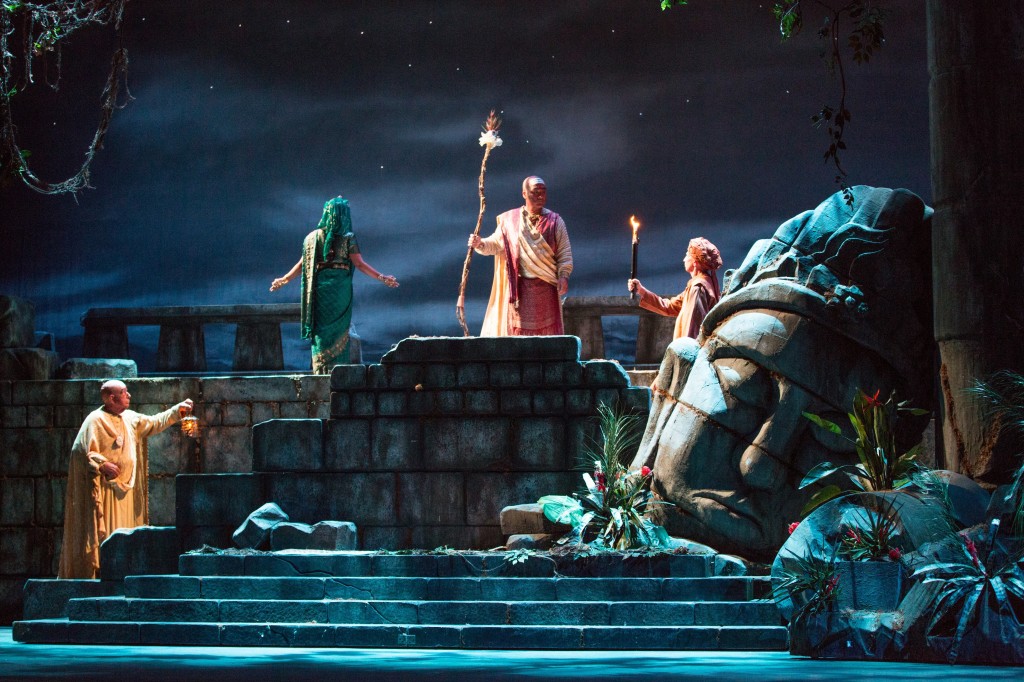
Sarasota Opera’s 2013 Winter Season production of Bizet’s THE PEARL FISHERS III. Photo by Rod Millington and Sarasota Opera
As already noted, the opera has been represented in countless “Greatest moments in opera” compilations by the strength of the famous duet between Zurga and Nadir, “Au fond du temple saint.” As sung in Sarasota by baritone Lee Poulis and tenor Heath Huberg, the duet provided that troubling experience of having all the ingredients in a recipe come together and yield a tasteless result. The orchestra was in full swing, the principals executed their task, all the right notes were sung, and yet the music remained very much earthbound. This phenomenon, which I like to call “the Deborah Voigt Effect,“ is one of those bizarre situations where the mind’s ear is not stimulated in a significant degree, and cannot recall what is being heard as one is hearing it. As the performance ran its course, it became clear that the principal men in this cast were good singers, but lacked the charisma and vocal personality to make this music crackle. Even more strange, the shared innocuous quality of their singing left very little to comment upon. Now, this is not a question of the size of voice, because Mr. Poulis and Mr. Huberg had no issues cutting through the orchestra. Rather, the actual sound and manner in which it was produced simply was not special enough to create much of an effect upon the ear (for that we would have to turn to the singing of bass Andrew Gangestad as Nourabad the High Priest, whose singing demanded the ear’s attention despite his small role). Of this duo, it was tenor Heath Huberg whose instrument appeared the most put together (a slight, pallid yet well produced voice through its range). Both singers made rudimentary attempts to wrap their voices around Bizet’s ardent phrases, and while their dicition was more than functional, they made little effort to use this very sexy, interesting language as a way to inform their singing. Both fulfilled the majority of their duties in like perfunctory fashion. We wish them well.
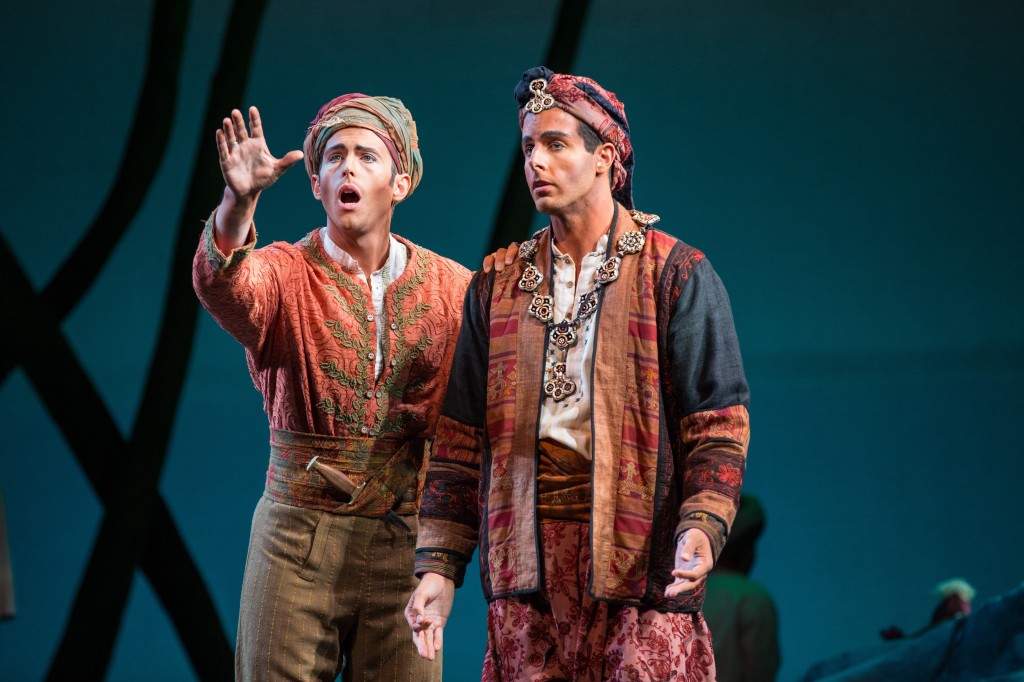
Tenor Heath Huberg as Nadir and baritone Lee Poulis as Zurga in THE PEARL FISHERS. Photo by Rod Millington and Sarasota Opera
Despite their agreeable appearance, both Mr. Huberg and Mr. Poulis did not move onstage very well, defaulting towards fidgety movements to pepper the proceedings. A negative side effect of this business rendered their various interactions with their leading lady unfulfilling, and a basic intimacy with the woman they love was never truly cemented. Here, some of the fault must be shared with the work of director Keturah Stickann, who could have told these guys to stand still, look at the soprano, and sing with a more substantial degree of honesty. Ms. Stickann was more successful in creating an impressive tableau (helped here by the beautiful sets of designer J. Michael Wingfield) through the forces of the chorus of Sarasota Opera Apprentice Artists, particularly during the storm scene and the opening of the third act.
If the male principals tipped the scale towards the subdued, the case of soprano Asako Tamura was a different matter. If personality she had in spades, it was her vocal choices that troubled most. Ms. Tamura is no stranger to newoutpost. Indeed we heard her score a triumph six years ago in New York when she replaced an ailing Aprile Millo in a double bill including Leoni’s “L’Oracolo” and Montemezzi’s “L’Incantessimo.” Our notes from that night, as collected in a sad little diary we used to keep back in those low-tech days, speak of a sizable voice with surprising Italianate undertones, which she unleashed towards the balconies with generous abandon. A big star sticker next to her name indicates our great hopes for the young singer, making the necessity of reporting the current state of her instrument a rather unsavory task. The tone has definitely lost significant freshness, and her top register has gained an undeniable hardness. In this presentation of “Les pecheurs de perles,” her performance as Leila could be summed up as vocally uneven while at times dramatically compelling. Her introduction in the first act was marred by a heavy-handed approach towards music that begged for a more delicate treatment. Throughout, she favored a broad approach (presumably as a way to maximize the production of the dark timbre that had impressed so much all those years ago), and this strategy did not serve her well: She gave too much too soon. Her tones unraveled as the demands of the score grew more ornate towards the end of the first act, and the throaty approach to her vocalise during “O Dieu Brahma!” impressed as squalid and forced. The more intense acts that followed would further aggravate the situation, but at the halfway point she would have enough voice to match her creativity, and yield a beautiful take on Leila’s act two aria “Comme autrefois dans la nuit somber”. In retrospect, it would be her best moment of the night.
She contributed some sweet, soft singing to her duet with Nadir, but a general unease in the more forceful phrases was difficult to ignore (a muscled stab at a climatic high Bb in the duet was prematurely abandoned). Her efforts to give the scene its dramatic due found her muscling her vocalism, and she mercilessly wrestled her remaining vocal resources into punishing digs to the chest register as a way to assist her interpretation. While this was not pretty to watch, Ms. Tamura’s struggles ultimately read as a valiant effort to express the passions of her character: A major point of difference from her male colleagues. Her efforts were duly noted by the audience, who rewarded her with their biggest ovation, and deservedly so.
For this performance, the opera’s score was best represtened by the forces of the Sarasota Opera Orchestra, kept together by the alert and vibrant baton of conductor Robert Tweten. The nature of live performance dictates that no two performances are the same, and as the cast nears its round of final dates of “Les pecheurs de perles,” we hope they have managed to iron out their various shortcomings. The remainder of Sarasota Opera includes the final performances of Puccini’s “Turandot”, as well as the company premieres of Verdi’s “Un giorno di regno” and Floyd’s “Of mice and men”. For more information, please visit www.sarasotaopera.org
-Daniel Vasquez
